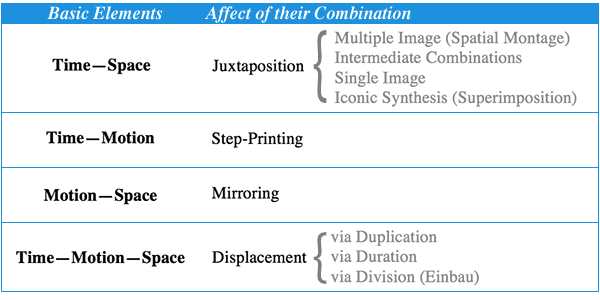PORTFOLIO |
 |
|
|
|
|
|
 |

|
| |

|
| |
 |
"Beyond Spatial Montage" part 4 of 6
story © Michael Betancourt | published November 20, 2014 | permalink |



 |
| 
|
 |


|
 |
|
This theory work will be published as a book-length monograph Beyond Spatial Montage: Windowing, or, the Cinematic Displacement of Time, Motion, and Space by Focal Press.
Part 4 of a 6 Part series proposing an expanded theorization of spatial montage, excerpted from a current book project.
Motion�Space Displacement (Mirroring)
The most easily identified variety of Motion�Space displacement, a tessellated array of (typically) triangular images, is immediately recognizable as being kaleidoscopic. However, any mirroring, even a simple vertical �reflection� on screen creating a symmetrical pattern would qualify as a Motion�Space displacement. These simple forms are the most common: mirroring is the earliest form of windowing to be developed since the visual structure happens continuously in �real time� since it does not require the motion picture as technological support�as a result, the first examples of this displacement are pre-cinematic. They appear in the eighteenth and nineteenth centuries as developments in kineto-optical devices (both photography and the motion picture are also examples of these scientific concerns). While a simple �split screen� (two images) would not be an example of this technique, if it were instead a mirroring of the frame (so long as it was not a superimposition of the frame flipped horizontally or vertically) it would qualify as the simplest variety of Motion�Space displacement. Complex versions with multiple reflections, often resembling a kaleidoscope, are more readily identified versions of this visual displacement.
|

|
|
 read more read more
|

|
| |
 |
"Beyond Spatial Montage" part 3 of 6
story © Michael Betancourt | published November 15, 2014 | permalink |



 |
| 
|
 |


|
 |
|
This theory work will be published as a book-length monograph Beyond Spatial Montage: Windowing, or, the Cinematic Displacement of Time, Motion, and Space by Focal Press.
Part 3 of a 6 Part series proposing an expanded theorization of spatial montage, excerpted from a current book project.
Time�Motion Displacement (Step Printing)
Time�Motion displacement is part of the foundational history of motion pictures. This type of sequential photograph, the chronophotograph, invented by the French scientist Etienne-Jules Marey, is immediately recognizable as representing a temporal shift where an identical, multiple-yet-singular formal structure of displacement is created entirely within a singular full-frame image. This displacement achieves a distinct juxtaposition and fragmentation of time and motion that is different in character and degree from �spatial montage��the spatial element extending across the screen, is incidental to the organization as it is motion that characterizes these repetitions. This displacement of the duration across the screen as the individual motion �echoes� violates the continuous long take in precisely the same way that editing and other forms of montage do, but without breaching the integrity of the individual shot. Superimpositions produced with an optical printer (or using video/digital processing) can produce a visual displacement called �step printing� that transforms the chronophotograph into a motion picture.
|

|
|
 read more read more
|

|
| |
 |
"Beyond Spatial Montage" part 2 of 6
story © Michael Betancourt | published November 10, 2014 | permalink |



 |
| 
|
 |


|
 |
|
This theory work will be published as a book-length monograph Beyond Spatial Montage: Windowing, or, the Cinematic Displacement of Time, Motion, and Space by Focal Press.
Part 2 of a 6 Part series proposing an expanded theorization of spatial montage, excerpted from a current book project.
The technologies of compositing and image combination directly contribute to the development of juxtaposed imagery. While the production of composite imagery is evident in the history of motion pictures since the first Trik films were made in the 1890s, the relative rarity of these images�even within the Trik film�remained relatively constant due to the difficulties of their production. The greatly reduced costs, coupled with relative ease of production with digital video has made the integration of live action, animation and graphic design via compositing a common feature of motion graphics and commercials even though it remains relatively unusual in narrative production.

The distinction between different potentials within the range of these forms is a function of the on-screen affect of the materials combined. For narratives with live actors and edited sequences of shots, these potentials have a more limited application. The apparent division and fragmentation of the screen into smaller, discrete units in narrative works remains unusual even as similar forms appear more frequently in the commercials and title sequences accompanying these realist fictions.
|

|
|
 read more read more
|

|
| |
|
|
|